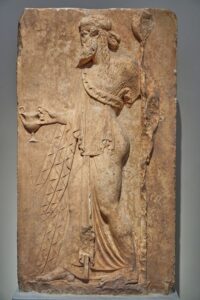The votive relief depicting the Greek god Dionysus, dating back to the 1st century B.C., stands as an exemplary piece of Ancient Greek art, blending religious symbolism with the evolving artistic trends of its time. Found in Loutses, an area between the districts of Chalandri and Agia Paraskevi in Attica, this marble relief offers a glimpse into the artistic and cultural landscape of the Hellenistic period.
The God Dionysus: Symbolism and Representation
Dionysus, often depicted as the god of wine, revelry, and ecstasy, is shown in this relief holding a kantharos in his right hand and a thyrsus in his left. The kantharos, a large drinking cup, is a symbol of Dionysus’s domain over wine and the intoxicating effects it has on humans. The thyrsus, a staff topped with a pine cone and wrapped in ivy, represents fertility, nature, and the god’s role as a leader of ecstatic rituals. These attributes emphasize Dionysus’s dual nature—his association with both the pleasures of life and the deeper, more chaotic forces of nature.

Artistic Style: Archaic Influence and the New-Attic Trend
The relief is executed in the Archaic style, marked by its emphasis on symmetry, formality, and the idealized representation of deities. However, its style also aligns with the New-Attic reliefs, a distinct artistic movement that emerged in the Hellenistic period. The New-Attic reliefs are known for their detailed yet restrained depiction of gods and mythological figures, often blending earlier classical forms with newer, more naturalistic features. While the figures maintain an air of solemnity and grandeur, there is also a sense of liveliness and fluidity that was characteristic of the Hellenistic era.

Historical and Cultural Context
During the Hellenistic period, the relationship between art and religion was evolving. Votive offerings like this relief were created not just as artistic expressions, but as acts of devotion. These reliefs were often placed in temples or public spaces, offering gratitude to the gods or seeking favor for specific needs. In the case of Dionysus, a god of both joy and madness, the votive relief likely reflected the community’s desire to invoke the deity’s favor for agricultural fertility, social harmony, or personal well-being.
The relief’s discovery in Loutses, in the heart of Attica, is significant. Attica, home to the city-state of Athens, was a cultural and artistic hub, and the region’s residents were deeply influenced by both the classical ideals of the past and the new artistic movements of the Hellenistic world. This blending of old and new, as seen in the relief, mirrors the broader cultural transition that was occurring during this period.
Conclusion: Preserving a Sacred Tradition
Today, this votive relief is housed at the National Archaeological Museum of Athens, where it remains a testament to the enduring legacy of Greek art and religion. Its representation of Dionysus, along with its stylistic elements, encapsulates the complexities of Greek mythology and the sophisticated artistry of the Hellenistic period. By offering a glimpse into the religious practices and aesthetic preferences of ancient Greeks, this relief continues to captivate scholars and visitors alike, serving as both a historical artifact and a work of timeless beauty.
